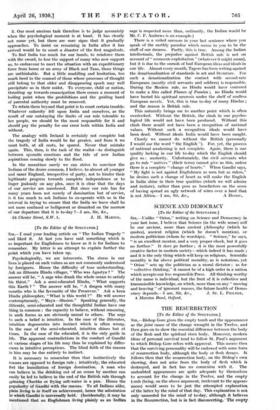THE RESURRECTION
[To the Editor of the SPECTATOR.] Sm,—Bishop Gore gives the empty tomb and the appearances as the joint cause of the change wrought in the Twelve, and then goes on to show the essential difference between the body of the flesh and the spiritual risen body. Moreover; modern ideas of personal survival tend to follow St. Paul's argument to which Bishop Gore refers' with approval. This means then that the surviving personality will be endowed with some form of resurrection body, although the body of flesh decays. It follows then that the resurrection body, on the Bishop's own showing, does not arise from the body of flesh which is destroyed, and in fact has no connexion with it. The undoubted appearances are quite adequate by themselves to account for the change in the Twelve, and the empty t3mb (being, on the above argument, irrelevant to the appear.. ances) would seem to be just the attempted explanation of the tatter by the mind of that day. This explanation is not only unneeded for the mind of to=day, although it believes in the Resurrection, but is in fact disconcerting. ' The empty. tomb in short makes belief in Our, Lord's Resurrection difficult for the modern mind as it introduces an unnecessary and unexpected element in such a way as to throw suspicion on the historical accuracy of the whole narrative.
Ignore the empty tomb, on the other band, and there is then no obstacle to belief in Our Lord's Resurrection with all its glorious consequences.
My point is that Bishop Gore says in effect that the empty tomb and the appearances stand or fall together, and then later shows, in effect, that there is no connexion between them, the body of the flesh and the resurrection body being totally different. As the subject is so vital to Christianity perhaps he, or some other equally competent orthodox theologian will deal with it in your columns.—I am, Sir, &c., LAYMAN.





































 Previous page
Previous page